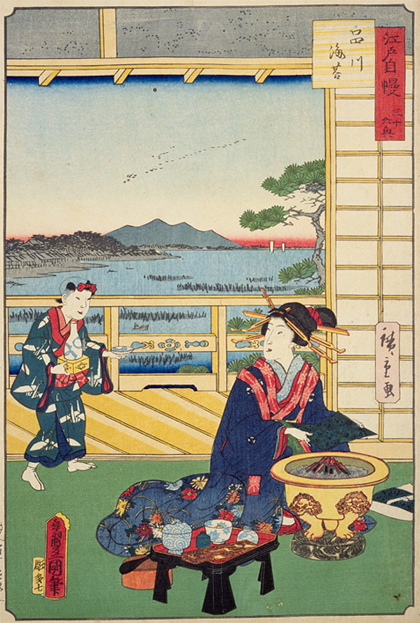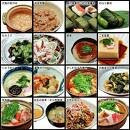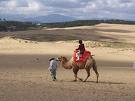::::::::::::::::::::::::::::::::::::::::::::::::::::::::::::::::::::::::::::::::::::::::::::::::::::
Grill, bake, broil, toast (yaku, yaki)
***** Location: Japan
***** Season: Topic
***** Category: Humanity
*****************************
Explanation
yaku 焼く ... can have many translations in English and is used for a variety of dishes.
Let us look at some famous yaku preparations.
Usually they are called xyz-yaki 焼き.
To do YAKU you can use a net over the grill or barbeque, a frying pan, frypan, or skillet, an oven toaster or an oven.
broiling in English usually refers to heat from above.

using a shichirin
Shichirin 七輪 portable cooking stove
for home grilling
. . . CLICK here for more Photos !
kiridashi shichirin 切り出し七輪 from the Noto peninsula 能登 are cut out of one piece of earth. They come in round or oblong forms for sanma fish.
. . . CLICK here for Photos of Noto Shichirin !
:::::::::::::::::::::::::::::::::::::::::::::::::::::::::::::::::::::::::::::::::::::::::::::::::::
furaipan, asanabe 浅鍋
see TOOLS
furaido フライド
This method came to Japan via the Europeans at the beginning of the Edo period.
Pieces are covered in a dough and fried as tempura or like this in a frypan.
ebifurai エビフライ
furaido onion フライドオニオン
furaido chikin フライドチキン
furaido poteto フライドポテト
:::::::::::::::::::::::::::::::::::::::::::::::::::::::::::::::::::::::::::::::::::::::::::::::::::
Aburi-yaki, aburiyaki あぶり焼き quick grilling
pass lightly over a flame, to make it crisp, for example nori seaweed.
. . . CLICK here for Photos !
Ami-yaki, amiyaki 網焼き grilled on a net
Grilled beef from Matsuzaka beef is a speciality of Mie prefecture
. . . CLICK here for Photos !
yakiami 焼き網 net for grilling
Chanchan-yaki, chanchanyaki ちゃんちゃん焼き
grilling salmon with vegetables on a hot plate
Online reference
. . . CLICK here for Photos !
Dora-yaki, dorayaki どらやき bun or cake with anko filling
It is named after a Japanese gong (dora). It can be filled with many things. It is the favorit food of the manga character Doraemon, of course.
Dorayaki (どら焼き, どらやき, 銅鑼焼き, ドラ焼き) bean-jam pancake
furai フライ "fried" (in the frying pan)
a kind of yakisoba-like very flat pancake (perapera), folded in half and
covered with yakisoba sauce
Speciality of Saitama 埼玉県の名物【フライ】
CLICK here for PHOTOS !
Another speciality is
serifurai ゼリーフライ "jelly fry", croquette
seri- comes from zeni, the form of the old gold money, koban, zenifurai, serifurai which has the same form as this kind of croquette (kurokke) made from okara tofu and potatoes, deep fried.
Hama-yaki, hamayaki 浜焼き grilled on the beach
local specialities are grilled directly on the beach.
Old method of the fishermen and divers to get warm.
saba no hamayaki, さばの浜焼き, speciality of Fukui.
たいの浜焼き tai no hamayaki is a speciality of Okayama.
Horoku-yaki, hoorokuyaki ほうろくやき (焙烙焼き)
. . . CLICK here for hooroku pot Photos !
roasted in an earthware pot. steam-baking
a kind of mushiyaki for seafood or vegetables
The Murakami priates used this pot filled with explosives as a weapon, hoorokutama 焙烙玉.
. . . CLICK here for Photos !
irdene Röstpfanne
http://kokonuggetyumyum.blogspot.com/2005/12/horoku-yaki.html
Hoosho-yaki, hooshoyaki, hoshoyaki 奉書焼き grilling wrapped in washi paper
. . . CLICK here for Photos !
すずきの奉書焼き suzuki no hoosho yaki, speciality of Tottori
Online reference
Ikayaki イカ焼き grilled squid
gegrillter Tintenfisch
Imagawa yaki 今川焼 (いまがわやき, 今川焼き)
kind of waffles filled with sweat bean paste
taikoyaki 太鼓焼(たいこやき), tomoeyaki 巴焼(ともえやき)、 gishiyaki 義士焼(ぎしやき)
Imagawayaki, KIGO for winter
Ishiyaki, ishi yaki 石焼き (いしやき) fried on stone
or baked or boiled with hot stones in water
ishiyaki nabe 石焼鍋 from Oga peninsula, Akita
- - - - - 石頭火鍋 in Taiwan
..... also
ishiyaki imo 薯 (やきいも) roasted sweet potatoes
Jibachi yaki... roasted bee or wasp larvae
Hachi no ko 蜂の仔(はちのこ, 蜂の子)bee and wasp larvae
jigoku yaki 地獄焼 grilling seafood alive
"Hellish griling"
Kabayaki, unagi no kabayaki うなぎのかば焼き
skewered grilled eel with a soy sauce
speciality of Tokyo
Kaiyaki, kai-yaki 貝焼 (かいやき) simmering seafood in shells
kayaki かやき
kigo for winter
Kara-yaki, karayaki から焼き (からやき, 殻焼き) grilled in the shell
kaki-karayaki, grilled oysters
grilled sazae
At the beach on the way from Kamakura to Enoshima.
A special form is the onigarayaki 鬼殻焼き of lobsters as a whole.
Also yoroiyaki よろい焼き or gozokuyaki 具足焼き, grilling in full armour
The back of the animal is cut open and some soysauce and mirin poored on it before grilling.
. . . CLICK here for Photos !
Kimi-yaki, kimiyaki 黄身焼き broiling with an egg yoke
The egg yoke is mixed with sake, mirin and salt, this mixture poored over the almost finished dish and then fried again.
Especially for squid and ebi prawns, white fish and pork.
Also called "golden fry" (oogon yaki 黄金焼き ).
. . . CLICK here for Photos !
http://www.isedelica.co.jp/recipe/nihon/sasami.htm
kurokke コロッケ croquette
Mashed ingredients deep-fried in a breadcrum cover. Potato croquettes are most popular, but they come in many flavors in Japan.
WASHOKU : Kurokke コロッケ croquettes
Miso-yaki, misoyaki みそやき (味噌焼き) broiled in miso sauce
often used for sake salmon or chicken
hoikoro, hoikoroo ホイコロー in the chinese cuisine, with cabbage and chicken or meat
. . . CLICK here for Photos !
Nabeyaki, nabe-yaki 鍋焼 (なべやき)stew in an earthen pot
with fish, meat and vegetables
Pieces are seared with very little oil in a pan before stewing.
nabeyaki udon 鍋焼饂飩(なべやきうどん, 鍋焼きうどん, 鍋焼き饂飩)
yaki udon, yakiudon 焼饂飩 udon noodles slightly fried in a pan, mixed with other food.
kigo for winter
. . . CLICK here for Photos !
Namban-yaki, nambanyaki, nanban yaki 南蛮焼き; 南蛮焼 (なんばんやき)
namban ... food preparations are usally "from the southern barbarians", introduced via Nagasaki from the Portugese around 1600.
Western Style fry
Nambanyaki sauce, hot miso or chili sauce
. . . CLICK here for Photos !
The word is also used for pottery from South Asia and China.
O-kariba-yaki, okaribayaki お狩場焼き (おかりばやき) in-the-field dish for hunting parties.
The shogun of Edo had his own kariba hunting grounds around the city.
slices of wild game and vegetables are grilled on charcoal
. . . CLICK here for Photos !
:::::::::::::::::::::::::::::::::::::::::::::::::::::::::::::::::::::::::::::::::::::::::::::::::::::
Okonomi-yaki, okonomiyaki お好み焼き (おこのみやき)"Japanese Pizza"
Online Reference
. . . CLICK here for Photos !
They come in a style from Osaka and one from Hiroshima. Often yakisoba are added to it to give it more volume. Served with a lot of Aonori and mayonaise. A fried egg is also served with it.
Osaka is sprinkled with red vinegar-ginger (benishooga) and lots of katsuobushi flakes.
monjayaki もんじゃ焼き is another term.

fuafua Daruma yaki フワフワだるま焼
It is made without flour, only yamato-imo yam 大和芋.
a kind of monjayaki もんじゃ焼.
オリジナルの“だるま焼”
だるまさんが焼いちゃった
Near Ebisu Station, Tokyo
www.bloom-co.jp/shop/darumasan/info.html
kakioko, kaki oko カキオコ oysters on okonomiyaki
kaki no okonomiyaki
. . . CLICK here for Photos !
. Okonomiyaki - Hiroshima style .
.......................................................................
monjiyakiya 文字焼き屋 selling "monjiyaki" in Edo
mojiyaki 文字焼き "frying letters", letting the dough drip from a spatula (shamoji) onto the hot pan, giving it patterns like letters.
This is the fore-runner of okonomiyaki.
moji . monji . monja . monjayaki

Most Monjiyaki-ya in Edo opened their stalls (yatai) during the many festival days of temples and shrines.
.......................................................................

monja yaki namae no yurai wa moji yaki
the origin
of the word "monjayaki"
is "writing letters "
............................................
杓子程筆では書けぬ文字焼屋
shamoji hodo fude de wa kakenu mojiyakiya
with a spatula
he writes better than with a pen -
the "fried letters" chef

source : blog.oricon.co.jp/masuda
. Food vendors in Edo .
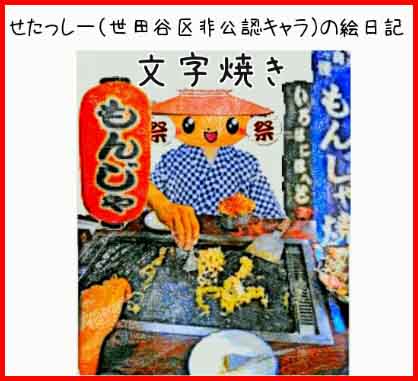
:::::::::::::::::::::::::::::::::::::::::::::::::::::::::::::::::::::::::::::::::::::::::::::::::::::
oyaki, o-yaki お焼き roasted rice dumplings from Nagano
. . . Himeji 姫路名物『お城やき』O-Shiro-Yaki
Castle waffles
Rooyaki 臘焼き (ろうやき)
a kind of kimiyaki
Roosoku yaki 蝋燭焼 (ろうそくやき, 蝋燭焼き) grilled craw's meat
kigo for winter
. Seriyaki 芹焼 (せりやき) dropwort stew with duck .
kigo for winter
Shigiyaki, shigi-yaki
Nasu no shigiyaki 茄子の鴫焼 (なすのしぎやき) fried egglpants with dengaku dressing
shigiyaki 鴫焼(しぎやき)
kigo for late summer
Shio-yaki, shioyaki 塩焼き grilled with salt
Often used for whole fish on sticks, like ayu trout over charcoal.
ayu trout is a speciality of Gifu
. . . CLICK here for Photos !
Röstenmit Salz; Braten mit Salz.
Shogayaki, Shoogayaki, shoga-yaki 生姜焼き, しょうが焼き Roast Ginger Meat
Sugiyaki 杉焼 (すぎやき)"preparing food in a cedar box"
hegiyaki 折ぎ焼き
kigo for winter
Sukiyaki, suki-yaki 鋤焼 (すきやき)
"food prepared on a spade"
gyuunabe 牛鍋(ぎゅうなべ)、uosuki 魚すき(うおすき)、okisuki 沖すき(おきすき)、torisuki 鶏すき(とりすき)、udonsuki 饂飩すき(うどんすき)
kigo for winter
WASHOKU : Sukiyaki Information
often prepared with warishita すき焼きわりした soy sauce mix (see soy sauce for explanation)
. . . CLICK here for warishita Photos !
sumibi-yaki, sumibiyaki 炭火焼 barbequing over charcoals
Tai-yaki, taiyaki Taiyaki 鯛焼 (たいやき, 鯛焼き) waffles filled with sweat bean paste
in the form of a sea bream (tai).
kigo for winter
Ningyooyaki, ningyoyaki 人形焼 figure waffles from Edo
Tako-yaki, takoyaki 蛸焼き ( たこやき) octopus balls
pan-fried ocotpus dumplings
A favorite for festival stalls.
Online reference
. . . CLICK here for Photos !
Oktopus-Teigbällchen
:::::::::::::::::::::::::::::::::::::::::::::::::::::::::::::::::::::::::::::::::::::::::::::::::::::
Teppan-yaki, teppanyaki
てっぱんやき, てっぱん焼, 鉄板焼き
fried (or grilled) on an iron plate or pan
In restaurants, the cooking can be done on a large iron plate (teppan) on the counter or on indivitual hot plates for a group of guests for socializing while eating.
The fried ingredients, mostly meat, fish and vegetables, are dipped in a special sauce, often the secret of a restaurant.
Meat can be marinated before grilling.
Steak, shrimp, okonomiyaki, yakisoba, and monjayaki are prepared on these iron plates.
Sizzling Plate.
. . . CLICK here for Photos !
Braten auf der Eisenplatte. Gemischte Grillplatte
quote
Origin
The originator of the teppanyaki-style steakhouse is the Japanese restaurant chain Misono, which introduced the concept of cooking Western-influenced food on a teppan in Kobe in 1945. They soon found that the cuisine was more popular with foreigners than with the Japanese, who enjoyed both watching the skilled maneuvers of the chefs preparing the food as well as the cuisine, somewhat more familiar than more traditional Japanese dishes. As the restaurants became popular at tourist spots with non-Japanese, the chain increased the performance aspect of the chef's preparation, such as stacking round slices of onion in the shape of Mount Fuji and lighting alcohol (usually sake) contained within on fire, producing a flaming onion volcano.
In Japan, many teppanyaki restaurants feature Kobe beef. Side dishes of mung bean sprouts, zucchini (even though zucchini is not a popular vegetable in Japan and rarely found in the market), garlic chips or fried rice usually accompany the meal. Some restaurants provide sauces in which to dip the food. However, in Japan, only soy sauce is typically offered.
© More in the WIKIPEDIA !
Reference : Misono Kobe
:::::::::::::::::::::::::::::::::::::::::::::::::::::::::::::::::::::::::::::::::::::::::::::::::::::
teppoo yaki, teppooyaki, teppoyaki 鉄砲焼き "hot gun grilling"
fish or meat is wrapped in red hot pepper miso paste and grilled.
speciality of Toyama
.................................................................................
Teri-yaki, teriyaki 照り焼き broiled after being soaked in sweetened soy sauce
Often used for chicken. Teriyaki chikin, done in a frypan.
usukuchi shooyu, thin soy sauce is best, because it gives a natural glaze and is saltier than normal soy sauce, so it can be used sparcely, but effectively to give a strong umami taste to the food.
. . . CLICK here for Photos !
das Teriyaki; in Sojasauce gebratener Fisch
. . . yuuanyaki, yuuan yaki 幽庵焼き(ゆうあんやき)
Yuan Yaki. Grilled fish or chicken a la teriyaki, first marinated in a mixture of light soysauce, sake and mirin, with lots of yuzu juice.
This marinade was first used by the gourmet, monk and tea master Kitamura Yuan (Yuuan) 北村祐庵 / 堅田幽庵(1648 - 1719) of the Edo period.
His name was also 道遂。幽安・幽庵・柚庵. He was the son of a rich family in Katata, Otsu, Shiga prefecture. He was one of the four great disciples of Sen Sotan 千 宗旦 (Sen Sootan) and learned also from Fujimura Yoken 藤村庸軒 (Fujimura Yooken). He also designed the famous garden Isomeshi Teien 居初氏庭園 in Otsu, Isomeshi's Garden .
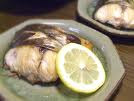
yuuanzuke, yuuan tsuke 幽庵漬け marinade a la Yuan
.................................................................................
toobanyaki とうばんやき. とうばん焼・燈板焼
tobanyaki, toban-yaki
method of cooking/grilling/roasting on a ceramic plate. The plates keep the food warm for a long time.Used for seafood and meat.
Tsuboyaki 壷焼 (つぼやき)
sazae turban shell fried in the conch
:::::::::::::::::::::::::::::::::::::::::::::::::::::::::::::::::::::::::::::::::::::::::::::::::::::
Yakimono 焼き物 (やきもの) Broiled seasonal fish
course in a kaiseki ryori meal
. . . CLICK here for Photos !
京懐石 Kyoo kaiseki, Kaiseki from Kyoto
yakizakana 焼き魚 grilled or broiled fish
fish with some sprinkles of salt.
Oil is not used in tradtional Japanese yakimono.
Grilled fish served in formal banquets was only eaten from the top side. It was bad manners to turn the fish around and eat the bottom side as well.
gebratener Fisch, Bratfisch, gegrillter Fisch
I wonder if this is done on a charcoal grill or in a frypan. And did the folks of Edo use frypans? How did they call it? Or when did it first show up in a frypan fried with oil?
yakishimozukuri 焼き霜づくり
grilling fish for a short time to change color on the outside, serving as sashimi.
searing over heat.
:::::::::::::::::::::::::::::::::::::::::::::::::::::::::::::::::::::::::::::::::::::::::::::::::::::
yakiboshi 焼き干し "grilled and dried" small sardines
yaki-doofu, yakidofu, yaki toofu 焼き豆腐 momen firm tofu which is slightly browned on both sides by broiling.
For the New Year, nishime, ni-shime 煮しめ is prepared, a yakidofu piece cooked in sweatened soy sauce together with other ingredinets.
. . . CLICK here for Photos !
. . . CLICK here for NI-SHIME Photos !
yaki-imo, yakiimo 焼薯 (やきいも) roasted sweet potatoes
kigo for winter
yaki-meshi, yakimeshi やきめし (焼き飯) fried rice
usually chahan, chaahan チャーハン
.... also
yakigome 焼米 (やきごめ) roasted rice (kigo for early autumn)
yaki-onigiri, yakionigiri 焼きおにぎり grilled rice balls
yaki-niku, yakiniku 焼き肉 (やきにく, 焼肉)
grilled slices of meat
Korean-style barbecued beef is quite popular too. Korean barbeque. Japanese barbeque.
Many restaurants specialize in this kind of food for a group of people to enjoy whilst socializing.
. . . CLICK here for Photos !
Online reference
One type is HORUMONYAKI ホルモン焼き horumon yaki, in the dialect of Kansai it means "things thrown away" hooru mono 放る物 and is not related to the western word "hormon". It is said to bring stamina to the tired worker in the evening and very popular
Other Korean dishes are Bibimba ビビンバ and Kimchee キムチ kimuchi, kimchi.
yaki-shimozukuri, yakishimozukuri 焼き霜作り "frost grilling"
used for sashimi raw fish to grill it just a second until it changes color. Dipped in ice water after grilling.
Also helps to get extra moisture out of frozen fish.
Often used for katsuo and tai. Sometimes the skin of the fish is left on one side.
. . . CLICK here for Photos !
yaki shio, yakishio 焼き塩 (やきしお, 焼塩) baked salt
table salt. Also used when baking in an earthware pan (hooroku).
Through the baking process the magnesium chlorid in the salt turns to magnesium oxide and takes out the bitterness of food.
. . . CLICK here for Photos !
- - - - - - - - - -
yaki-soba, yakisoba 焼き蕎麦、やきそば fried noodles, not necessarily buckwheat noodles
literally "fried noodles in sauce", is considered a Japanese dish but originated in China and is technically a derivative of Chinese chow mein.
© More in the WIKIPEDIA !
- - - kuro yakisoba 黒焼きそば "black yakisoba" from Higashimurayama, Tokyo 東京都東村山市
with octopus ink sauce
and more . Regional yakisoba dishes .
Yakisoba Sandwich Recipe external LINK
Reference : Yakisoba Sauce
Kuroishi tsuyu yakisoba 黒石つゆやきそば / 黒石焼きそば
fried noodles in soup made from yakisoba sauce
- - - - - - - - - -
yaki-tori, yakitori やきとり (焼き鳥) grilled (barbecued; broiled) chicken on a skewer.
usually bamboo skewer
A favorite dish at the izakaya restaurants.
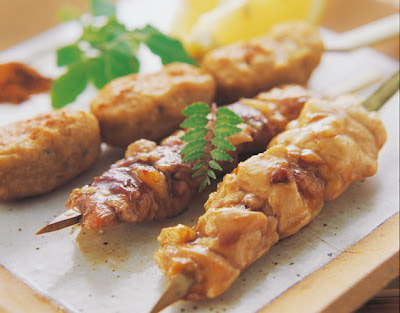
yooganyaki yoogan yaki 溶岩焼き cooked on heated peaces of lava
CLICK here for PHOTOS !
*****************************
Worldwide use
*****************************
Things found on the way
*****************************
HAIKU
一匹も釣れずオトリを塩焼きす
ippiki mo tsurezu otori o shioyaki su
not one fish caught ...
we decide to use the bait
for salt grilling
Arasaga あらさが
:::::::::::::::::::::::::::::::::::::::::::::::::::::::::::::::::::::::::::::::::::::::::::::::::::::
七輪の炭赤々と妻照らす
shichirin no sumi aka-aka to tsuma terasu
the red red charcoal
of the outdoor cooking stove ..
it shines on my wife
midnightsapporo 2006
*****************************
Related words
***** . Barbeque
kigo for summer in Europe
***** WASHOKU : Regional Japanese Dishes
***** WASHOKU : COOKING METHODS
:::::::::::::::::::::::::::::::::::::::::::::::::::::::::::::::::::::::::::::::::::::::::::::::::::::::::::::::::::::::::::
[ . BACK to DARUMA MUSEUM TOP . ]
[ . BACK to WORLDKIGO . TOP . ]
:::::::::::::::::::::::::::::::::::::::::::::::::::::::::::::::::::::::::::::::::::::::::::::::::::::::::::::::::::::::::::





